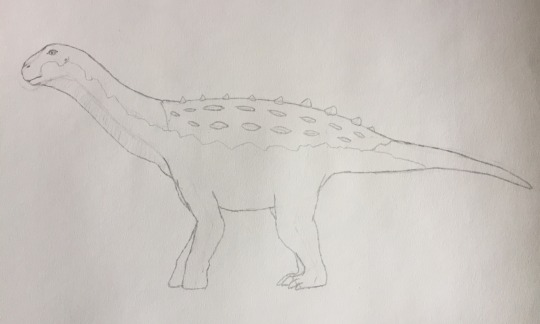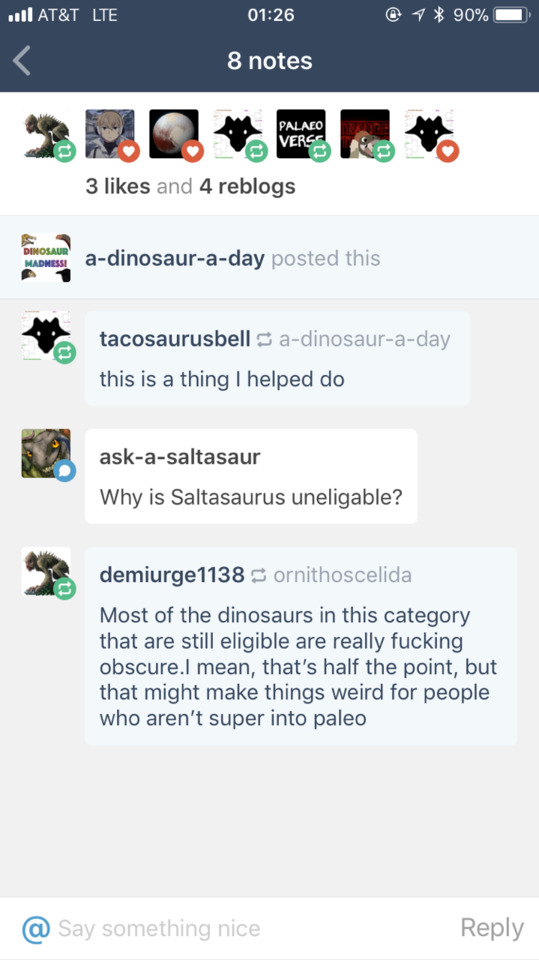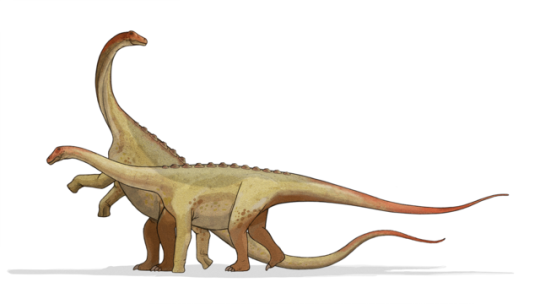#saltasaurs
Text

A Titanomachya going for a stroll during some light rain.
#art#my art#digital art#paleoart#paleontology#palaeoblr#archosaurs#dinosaurs#sauropodomorphs#sauropods#titanosaurs#saltasaurs#titanomachya
89 notes
·
View notes
Text

Neuquensaurus australis, a saltasaurid titanosaur from Cretaceous Argentina. The defining trait of this group is their prevalent osteoderms (bones set in the skin) that make them look almost like long-necked ankylosaurs.
8 notes
·
View notes
Text
The ultimate power move in palaeontology is spelling Opisthocoelicaudia 100% correct on the first try without having to check any references.
#palaeontology#paleontology#paleo#palaeoblr#paleoblr#opisthocoelicaudia#jesus that is hard to spell#dinosaur#dinosaurs#sauropod#sauropods#titanosaur#titanosauria#saltasaur#spelling
96 notes
·
View notes
Text
Fuck it batshit archosaur concepts that should've happened
Bipedal Stegosaurid or bipedal Ankylosaurian that branched out from Scutellosaurus
Successful predatory sauropods that look nothing like sauropods (nor theropods) until you look up its classification and it says Sauropodamorpha (if Hererrasaurids aren't already this)
Lambeosaurine with increasingly weird crest and one that looks like a conch
Lambeosaurines with crest antlers to get revenge on those dastardly tyrannosaurids (like imagine the shapes they can have omg, lance-like similar to ceratopsid horns or split like deer antlers)
Idk how to articulate it but at least let Plateosaurs survive another million years I wanna see what will they become if they survived
Snaky Spinosaurids (like current spino but more snek and less arm, bootleg mosasaurus)
burrowing land pterosaurs that use their wings to dig and not fly
Cookiecutter shark pesky Anurognathids that bite large dinosaurs for food
Saltasaurs with giant Ampelosaurus-castle like backs which are really just impractical irl
#dinosaur#fossil#palaeontology#palaeoblr#palaeomeme#palaeoart#palaeontology memes#palaeontology meme#dinosaurs#biology#archosauria#sauropoda#pterosauria#hadrosauria#theropoda
3 notes
·
View notes
Note
Do you have any resources that could give me a good overall explanation of dinosaur classification? I’m pretty new to paleoblr and I get mixed up with all of the names floating around. Thanks and sorry if I bothered you!
I don’t - but I’ll be happy to write a bit!
1. What is a “Dinosaur”?
This may seem obvious, but it’s a bit more subtle. To scientists, “Dinosauria” is a group containing the most recent creature that was the ancestor of T. rex, Triceratops, and Brontosaurus, and everything descended from that ancestor. This means that birds, as descendants of dinosaurs, are included under that definition, while pterosaurs and most mesozoic sea reptiles like plesiosaurs are not.
This kind of group is called a “node-based group”, and is written as (Tyrannosaurus+Triceratops+Brontosaurus).
There’s also “stem-based groups”, which is “everything closer related to X than to Y”. A good example of this is reptilia, which is something like (Alligator>Homo) [that is, everything closer to alligators than to people!].
2. 3 main groups
There’s three main groups of dinosaurs - theropods, sauropodomorphs, and ornithischians. The simplest (though not always accurate) way of thinking about these is that theropods are two-legged meat-eaters, sauropodomorphs are long-necked plant eaters, and ornithischians are beaked plant-eaters.
For a long time it was accepted that theropods and sauropodomorphs were each others’ closest relatives, in a group called saurischia, and that this group was in turn the closest relatives of ornithischians. Recent analyses show that this may not be entirely accurate - it may be that theropods and ornithischians are united in a group called ornithoscelida, and that sauropodomorphs are the closest relative of this group. There’s good reasons to think each is true, and there’s going to need to be more research done in the future, and hopefully more fossils will straighten things out.
3. Ornithischia
Nearly all ornithischians have three things in common:
They’re mainly herbivores
They have a special bone on their lower jaw called a predentary that formed part of a beak
Part of their hips faces backwards, allowing more room for guts (important because plants are hard to digest!)
There’s three main groups of ornithischians, as well as a bunch that don’t really fit into any of those groups.
The most significant of these “oddballs” are the heterodontosaurs, a group of early ornithischians that mainly lived in the jurassic and triassic periods. They’re generally small (60-200cm in length) two-legged omnivores or herbivores that had big fangs that were probably used for display. They’re kind of the weird cousins of all other ornithischians.
Thyreophorans
This literally means “shield bearers”, and as you might expect it includes the armoured dinosaurs like Stegosaurus and Ankylosaurus. It also includes some weird early forms like Scutellosaurus. It’s defined as (Ankylosaurus>Triceratops).
>Eurypods
This is specifically (Stegosaurus+Ankylosaurus), so it’s contained within thyreophora.
>>Ankylosauria
This is (Ankylosaurus>Stegosaurus), and contains the most heavily armoured dinosaurs. It’s divided into Ankylosauridae (ones with tail clubs), Nodosauridae (which have bigger shoulder spikes), and possibly also Polacanthidae (which have more sticky-up spikes, but also might just be nodosaurids)
>>Stegosauridae
This is (Stegosaurus>Ankylosaurus), and contains the familiar plated dinosaurs. It includes Stegosauridae (the big ones like Stegosaurus) and Huayangosauridae (some smaller Chinese forms).
Neornithischia
This group is defined as (Parasaurolophus>Stegosaurus/Ankylosaurus). It contains two major groups - the Marginocephalians and the Ornithopods, but also a bunch of important basal members, like Thescelosauridae, Kulindadromeus and Hypsilophodon - animals that were once thought to be ornithopods but probably aren’t.
Marginocephalia
This is (Pachycephalosaurus+Triceratops). The name means “rimmed head”, because….both major groups have big stuff around their heads.
>Pachycephalosauria
These are the “bone-headed” dinosaurs like Pachycephalosaurus. It’s (Pachycephalosaurus>Triceratops)
>Ceratopsia
This is (Triceratops>Pachycephalosaurus), and contains the beakiest of all dinosaurs. Chaoyangosaurids are frill-less, hornless, 2-legged forms; Bagaceratopsids, Leptoceratopsids, and Protoceratopsids are hornless but increasingly frilled and 4-legged groups.
>>Ceratopsidae
This is (Centrosaurus+Triceratops), and contains the big, 4-legged, horned guys. Centrosaurines usually have smaller frills with big horns around them, smaller brow horns, and bigger nose horns, while Chasmosaurines usually have bigger frills, bigger brow horns, and smaller nose horns.
Ornithopoda
This is (Parasaurolophus>Triceratops). It used to contain a bunch more stuff, but now it mostly contains just Iguanodonts, so for most purposes those are the same thing (except for some southern forms called Elasmaria that don’t come up much). Doesn’t matter as much as it used to; them’s the breaks. It includes Rhabdodontids, a weirdogroup of small bipedal guys from Europe, and Dryomorpha.
>>Dryomorpha
This is (Dryosaurus+Iguanodon). It contains Dryosauridae, a group of fast-running ornithopods, and Ankylopollexians, the group that had the famous “thumb-spikes).
>>>Styracosterna
Except for a few species, this is about the same as Ankylopollexia. It contains a bunch of species, most of which used to just be called Iguanodon, as well as the Hadrosauriformes, which contains the Hadrosauroids, which contains the Hadrosauromorphs, which contains the Hadrosaurids (whew!)
>>>>Harosauridae
These are the “Duck-bills”. It contains the Lambeosaurines, which had big long hollow crests they could use to HONK !, as well as the Hadrosaurines, which didn’t have hollow crests.
4. Sauropodomorpha
This group is mainly made up of long-necked plant eaters. It starts off with a bunch of things we used to call “Prosauropods”, but now call…….basal sauropodomorphs. It may include Herrersauridae (Pedants be quiet), a group of early, early predators. It probably includes Guaibasaurids, a group of small omnivores from the triassic. It also includes Plateosaurids, a group of larger (but still bipedal), long-necked herbivores. From here we go into Massopoda, a group that includes Massospondylids and Riojasaurids, which…are similar to plateosaurids, as well as Sauropodiformes.
Sauropodiformes is where we start to get more sauropod-y, though we still have to zoom through Anchisauria to get to actual sauropods. We’re there now.
Sauropoda
These guys are actually quadrupedal! Here we’ve got….more sliding groups. There’s a bunch of early sauropods that are quite cool, but I’m not gonna name them. The fun group is Gravisauria. This includes some early guys calls Vulcanodonts, and Eusauropods,
Eusauropods include – you guessed it! More grades. There’s some interesting features here though - Mamenchisaurids are a bunch of Chinese forms with super long necks, and I can’t say I know anything remarkable about Turiasaurs. You’ll have to talk to John about that one.
Neosauropoda
Here’s where you’ll start recognising things if you haven’t already. This is (Saltasaurus+Diplodocus), and contains the most famous sauropods. It’s split into two main groups.
>Diplodocoidea
There are the “whip-tails” (again, pedants be quiet!). It contains Dicraeosaurids, a few weird, short-necked, double sailed things, Rebbachisaurids, a group of wide-mouthed weirdos, and Diplodocids, the famous great swan-necked ones that are some of the largest dinosaurs ever.
>Macronaria
This group contains some basal forms like Camarasaurus, and two main groups (Maybe?? This is kind of a contentious area). Brachiosaurids include the giant, super-tall ones, and some little ones also. Then there’s the monster that is Somphospondyli. This contains….more grades, the Euhelopodids, and the Titanosaurs.
>>Titanosauria.
This is a real monster, let me tell you. It includes more grades – yay! – and Lithostrotia.
>>>Lithostrotia
This is where titanosaurs start getting armoured (except it’s not really that simple, since others have armour, and it may have evolved multiple times, and…..lots of stuff). It also includes the real giants like Lognkosaurs, Aeolosaurs, and Saltasaurs.
5. Theropods
These are the two-legged meat-eaters – although many are omnivorous or herbivorous! They include some early forms and Neotheropods. (From here on, except when notes, groups in big font include the rest of the groups listed below).
Neotheropods
These include the early, long-necked Coelophysoids and Dilophosaurids (which may well be more advanced possibly even Tetenurans!). This group also contains the:
Averostrans
Literally “bird beaks”, although they didn’t all have beaks. It includes the Ceratosaurs, a group that contains some weird forms, and the Abelisaurs (large, short-armed, and bulldog faced) and the Noasaurs (Small, longer arms, need a good orthodontist).
Averostrans also include the:
Tetenurans
Named after their stiffened tails, around here is where theropods lost their fourth finger. After some basal forms it includes the:
>Megalosauroids
These consist of two main groups - the heavily built Megalosaurids and the fish-specialist Spinosaurids.
Tetenurae also includes the:
Avetheropods
This consists of the Carnosaurs and the Coelurosaurs.
>Carnosaurs
These are your big sauropod killers. They include Metriacanthosaurids and Allosaurids, as well as Carcharodontosaurians. This last group is divided into Carcharodontosaurids, which includes some of the largest predators ever to walk the Earth, and the Neovenatorids, a smaller group that MAY contain the Megaraptorans.
The other group of avetheropods is the:
Coelurosaurs
This is the earliest that we can definitively say, with pretty good certainty, that all members had feathers. It includes some basal forms and the:
Tyannoraptors
….which hands-down win the coolest name competition. This group includes the Tyrannosauroids, which I’m sure need no introduction.
It may also include the famously small Compsognathids, but those may also be outside tyrannoraptora.
It also contains the:
Maniraptoriformes
This group is the earliest we can say that all members had wings. It includes the famous “ostrich dinosaurs” or Ornithomimosaurs, and the:
Maniraptora
This group is where we first see the wing-folding ability like in modern birds. It includes the tiny, 1-fingered Alvarezsauroids and, at the other end of the spectrum, the giant, long-necked, pot-bellied, wickedly-clawed, plant-eating Therizinosaurs. It also includes the:
Pennaraptors
This group is the earliest place we see true vaned feathers. It includes the Oviraptorosauria, a group of typically beaked and crested omnivores and herbivores, as well as the
Eumaniraptors
AKA Paravians - it’s the difference between a stem-based and node-based group, but they’re essentially the same.
This group includes the really birdy things, like Anchiornis and the dragon-like Scansoriopterygids (really rolls off the tongue after some practice, I promise!). It also includes the famous “Raptors” – the Dromaeosaurids. There’s also the sickle-clawed but more omnivorous or herbivorous Troodontids, famous for their brains. This latter group may be a sister group to Dromaeosauridae, or it may be closer to:
Avialae
This is (Passer>Troodon, Deinonychus). It’s what most scientists would call “birds”. It includes some early forms exemplified by Archaeopteryx and Jeholornis, as well as:
Pygostylia
This is birds with shortened, fused tails. It’s (Confuciusornis+Passer), and includes the cool streamer-tailed Confuciusornithids. It also includes:
Ornithothoraces
This group of birds is (Enantiornis+Passer). It includes the very successful and widespead (but now extinct) bird group called the Enantiornithines. It also includes the
Euornithines
This is where we first see birds with modern-style tails. It includes some basal forms at the
Ornithuromorphs
This group contains some early groups, the Hongshanornithids and the Songlingornithids, and the:
Ornithurans
This is sort of the “last burst” before we get to true birds! It includes the seagull-like Ichthyornis and the seal-like Hesperornithines. From here on out, everything is included in the:
Neornithines
We’ve made it! This is true birds - no teeth here. From here we’re divided into – What, did you think we were done? – we’re divided into the Palaeognaths and the Neognaths.
Palaeognaths include giant flightless birds like ostriches and emus, as well as the kiwi and the chicken-like Tinamids.
Neognaths
This contains all the familiar birds.
One major group is the Galloanserans.
These include the Odontoanseres, possibly* including the albatross-like Pelagornithids as well as the famous “horse-eating” (but actually vegetarian) Gastornithids and Dromornithids, and ducks, geese, swans, and screamer birds in Anseriformes.
*Pelagornithids may be more basal galloanserans or neognaths
Galloanserae also includes Pangalliformes, which consists of megapode fowl, chickens, turkeys, pheasants, peacocks, the whole shebang.
Neognathae also includes the:
Neoaves
From here taxonomy does get a bit muddled for a while. I’ll present the two major hypotheses.
1. Columbea/Passerea hypothesis
The Columbimorphs consists of Columbiformes or pigeons and doves, Pteroclidoformes or sandgrouse, and Mesitornithiformes or Mesites.
Columbimorphs may be closest to Mirandornithes, which consists of Phoenicopteriformes or flamingoes, and Podicepidiformes or grebes. If so, this clade is called Columbea.
The rest of the birds in this hypothesis belong in a clade called Passerea.
Otidomorphs are a group consisting of Otidids or bustards, Cuculiformes or cuckoos, and Musopagoformes or turacos.
Otidomorphs may be closest to Strisores, which include Apodiformes (Hummingbirds and swifts) and Caprimulgiformes (Nightjars, owlet-nightjars, and frogmouths). In this case their clade is Otidae, not to be confused with Otididae.
The rest of the birds in this hypothesis clade together in a clade called Litoritelluraves.
Gruae may be a group consisting of Opisthocomids (Hoatzins), Charadriiformes (Gulls, terns, puffins, plovers, sandpipers), and Gruiformes (Cranes, rails).
The rest of the birds in this hypothesis clade together in an unnamed clade.
This group contains the Telluraves (more on them later!) and the:
Ardeae
This consists of Eurypygimorphs, consisting of Eurypigids (Sunbitterns) and Phaethoniformes (Tropicbirds).
Ardeae may also include:
Aequornithes
This group of waterbirds includes Gaviiformes (divers/loons), Austrodyptornithes (a clade that includes Sphenisciformes [Penguins] and Procellariiformes [Albatrosses, petrels]), Ciconiiformes (Storks), Suliformes (Boobies, gannets, cormorants), and Pelicaniformes (Pelicans, herons, ibises).
2. Columbaves Hypothesis
Strisores may be the earliest to branch off of Neoaves.
Columbimorphs may alternatively be closest to Otidomorphs, If so, this clade is called Columbaves.
The rest of the birds in this hypothesis clade together in an unnamed clade.
Gruiformes may have been the earliest to branch off in this clade.
The rest of the birds in this hypothesis clade together in an unnamed clade.
The Aequorlitornithes (Not to be confused with Aequornithes) may consist of Mirandornithes clading with Charadriiformes as a sister group to a clade between Eurypygimorphs and Aequornithes.
Also included in this unnamed clade is the
Inopaves
This may consist of Opisthocomids and Telluraves.
Telluraves – Back to your regularly scheduled program
There’s actually, to my knowledge, some degree of concensus here. It’s divided into two main groups - Afroaves and Australaves.
Australaves consists of Cariamiformes (seriemas and terror birds) and Eufalconimorphae.
>Eufalconimorphae consists of Falconiformes (Falcons, kestrels, and caracaras), as well as Psittacopasserans.
>>Psittacopasserans consist of Psittacoformes (Parrots and their ilk) and Passeriformes (Perching birds, which I’m not going into more detail on because I’d be here for a month).
Afroaves
This clade consists of Accipterimophs (New-world vultures, hawks, eagles, old-world vultures, kites), and an unnamed clade.
Unnamed clade
This clade consists of Strigiformes (owls and kin) and Coraciimorphs.
Coraciimorphs
This clade consists of Coliiformes (mousebirds), the cuckoo-roller, and Cavitaves.
Cavitaves
This clade consists of the Trogonids (Trogons and Quetzals) and the Picocoraciae.
Picocoraciae
This clade consists of Bucerotiformes (Hornbills, hoopoes, woodhoopoes) and the Picodynastornithes.
Picodynastornithes
Last one! This consists of Coraciiformes (Kingfishers, rollers, motmots, and bee eaters), and the Piciformes, or toucans, barbets, and woodpeckers.
230 notes
·
View notes
Photo

@ask-a-saltasaur because it was in the first year. @demiurge1138 yeah that is a real problem, and we have some plans on how to fix it in upcoming years
8 notes
·
View notes
Photo

Artistic reconstruction of a pair of Saltasaurs.
29 notes
·
View notes
Text
Equateur : découverte d’une nouvelle espèce de dinosaure «nain» - Le Parisien
Les fossiles exhumés datent du Crétacé et appartiennent au genre des saltasaures, des dinosaures qui ont vécu il y a 85 à 65 millions d’années et sont considérés comme étant les derniers à être apparus sur Terre, juste avant l’extinction des dinosaures.
0 notes
Text
Sauroposidon
Diplodocus
Sauropelta
Elasmasaurous
Saltasaurous
Titanoboa
Megatherium
0 notes